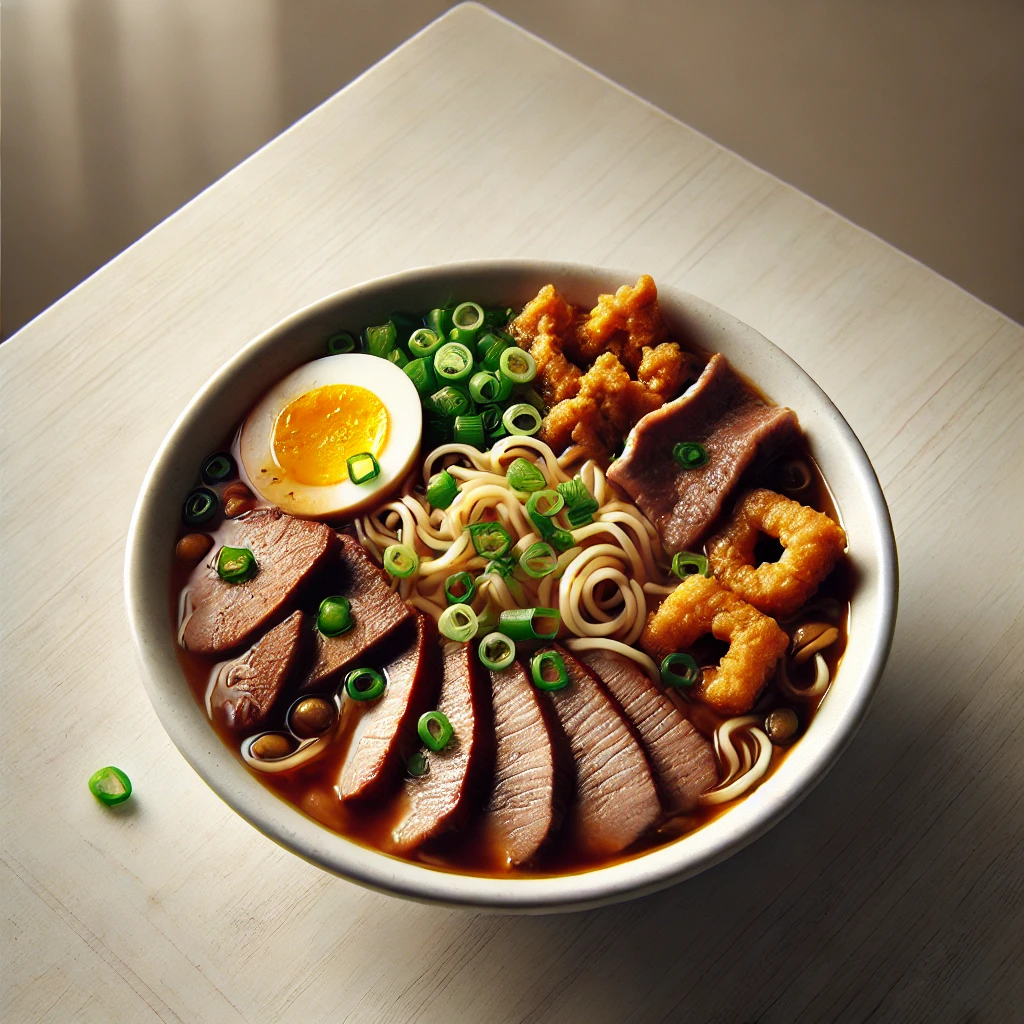Have you ever tasted a soup that feels like a warm hug for your soul? Let me introduce you to La Paz Batchoy, a Filipino culinary treasure that has been comforting hearts and satisfying taste buds for generations. This hearty noodle soup, hailing from the vibrant city of Iloilo in the Philippines, is not just a meal – it’s a journey through flavors, textures, and cultural heritage.
Picture this: a steaming bowl of rich, savory broth, filled with tender egg noodles, crispy pork cracklings, and an assortment of succulent meats. The aroma alone is enough to make your mouth water, but it’s the complex layers of taste that truly set La Paz Batchoy apart. From the umami-packed broth to the satisfying crunch of chicharon (pork cracklings), every spoonful is an adventure for your palate.
What makes La Paz Batchoy truly special is its roots in Filipino culture. Born in the La Paz district of Iloilo City, this soup has become more than just a local delicacy – it’s a symbol of Ilonggo culinary prowess and hospitality. Whether you’re a meat lover or someone who appreciates a good bowl of soup, La Paz Batchoy has something to offer everyone. While it’s traditionally meat-heavy, vegetarian adaptations are possible, making it a versatile dish that can be enjoyed by many.
So, are you ready to embark on a culinary adventure and bring a taste of Iloilo into your kitchen? Let’s dive into the world of La Paz Batchoy and discover how to create this comforting masterpiece in your own home.
Recipe Ingredients
Before we start cooking, let’s gather all the ingredients you’ll need to create your very own La Paz Batchoy. This recipe serves 4-6 people, perfect for a family dinner or a small gathering with friends.
| Ingredient | Quantity |
|---|---|
| Egg noodles | 500g |
| Pork belly | 250g, sliced thinly |
| Pork liver | 150g, sliced thinly |
| Beef loin | 200g, sliced thinly |
| Pork broth | 2 liters |
| Garlic | 8 cloves, minced |
| Onion | 1 large, chopped |
| Shrimp paste (bagoong) | 2 tablespoons |
| Fish sauce (patis) | 2 tablespoons |
| Salt | To taste |
| Ground black pepper | To taste |
| Chicharon (pork cracklings) | 1 cup, crushed |
| Spring onions | 1/2 cup, chopped |
| Raw egg yolks | 4-6 pieces |
| Vegetable oil | 2 tablespoons |
Substitution suggestions:
- For a healthier option, you can use chicken breast instead of pork belly.
- If pork liver is not available, you can omit it or use chicken liver as an alternative.
- Vegetarians can replace the meat with firm tofu and mushrooms, and use vegetable broth instead of pork broth.
- For a gluten-free version, replace egg noodles with rice noodles.
Recipe Instructions
Now that we have all our ingredients ready, let’s start cooking this delicious La Paz Batchoy. Follow these steps carefully, and you’ll be rewarded with a bowl of comforting goodness that transports you straight to the streets of Iloilo.
- Prepare the broth
- In a large pot, heat the vegetable oil over medium heat.
- Add the minced garlic and chopped onion. Sauté until the onions are translucent and the garlic is fragrant.
- Pour in the pork broth and bring it to a boil.
- Once boiling, reduce the heat and let it simmer.
- Cook the meats
- Add the sliced pork belly to the simmering broth. Cook for about 15 minutes or until tender.
- Add the beef loin and cook for an additional 10 minutes.
- Lastly, add the pork liver and cook for 5 more minutes.
- Season the broth
- Add the shrimp paste and fish sauce to the broth. Stir well to combine.
- Taste the broth and adjust the seasoning with salt and ground black pepper as needed.
- Let the broth simmer for another 5 minutes to allow the flavors to meld.
- Prepare the noodles
- In a separate pot, bring water to a boil.
- Cook the egg noodles according to package instructions until al dente.
- Drain the noodles and set aside.
- Assemble the La Paz Batchoy
- Divide the cooked noodles among 4-6 serving bowls.
- Ladle the hot broth over the noodles, making sure to include a generous portion of meat in each bowl.
- Top each bowl with a sprinkle of crushed chicharon, chopped spring onions, and a raw egg yolk in the center.
- Serve and enjoy
- Serve the La Paz Batchoy immediately while it’s hot.
- Instruct your guests to break the egg yolk and mix it into the hot soup before eating.
Helpful tips:
- For a richer broth, you can add pork bones while simmering and remove them before serving.
- If you prefer a spicier soup, you can add some chili flakes or sliced bird’s eye chili to the broth.
- To achieve the authentic La Paz Batchoy experience, serve the soup in a hot bowl to keep it warm throughout the meal.
Recipe Tips & Variations
La Paz Batchoy is a versatile dish that allows for various customizations. Here are some tips and variations to help you make the most of this delicious soup:
Customization tips:
- Adjust the meat ratio according to your preference. Some people prefer more pork, while others might want to increase the amount of beef.
- If you like your soup with more depth, try roasting the garlic before adding it to the broth. This will give your Batchoy a nice, smoky flavor.
- For a heartier meal, you can add some blanched vegetables like bok choy or spinach to the soup.
Troubleshooting:
- If your broth is too salty, add a peeled and quartered potato to the soup. The potato will absorb excess salt. Remove it before serving.
- If the broth is too thin, you can thicken it by adding a cornstarch slurry (mix 1 tablespoon of cornstarch with 2 tablespoons of cold water).
Variations:
- Seafood lovers can create a Seafood Batchoy by replacing the meat with shrimp, squid, and fish slices.
- For a fusion twist, try using udon noodles instead of egg noodles for a Japanese-inspired Batchoy.
- Experiment with different toppings like fried garlic chips, crispy shallots, or even a squeeze of calamansi (Filipino lime) for added zest.
Storage instructions:
- Store the broth and cooked meats separately from the noodles in airtight containers in the refrigerator. They will keep for up to 3 days.
- When reheating, warm the broth and meat on the stovetop, and prepare fresh noodles for the best texture.
- Avoid freezing the assembled soup as the noodles may become mushy when thawed.
Nutritional Information
While La Paz Batchoy is undoubtedly delicious, it’s also important to be aware of its nutritional content. Here’s an approximate breakdown of the nutritional information per serving (based on 6 servings):
| Nutrient | Amount per serving |
|---|---|
| Calories | 650 |
| Total Fat | 35g |
| Saturated Fat | 12g |
| Cholesterol | 180mg |
| Sodium | 1200mg |
| Total Carbohydrates | 55g |
| Dietary Fiber | 2g |
| Protein | 35g |
Please note that these values are estimates and may vary depending on the specific ingredients used and portion sizes.
Conclusion
As I sit here, savoring a steaming bowl of La Paz Batchoy, I’m transported back to my first visit to Iloilo. The bustling streets, the warm smiles of the locals, and the intoxicating aroma wafting from the numerous Batchoy houses – it all comes flooding back with each spoonful. This dish is more than just a meal; it’s a celebration of Filipino culinary heritage, a testament to the creativity and resourcefulness of the Ilonggo people.
Creating La Paz Batchoy at home might seem like a daunting task at first, but I assure you, the effort is well worth it. The joy of sharing this hearty soup with family and friends, watching their eyes light up as they take their first bite – it’s an experience that can’t be matched. So, I encourage you to roll up your sleeves, gather your ingredients, and embark on this flavorful journey.
Remember, cooking is an art, and like any art form, it thrives on experimentation and personal touches. Don’t be afraid to adjust the recipe to suit your taste preferences. Maybe you’ll discover a new variation that becomes your family’s favorite!
I’d love to hear about your La Paz Batchoy adventure. Did you try the recipe? How did it turn out? Did you make any interesting modifications? Share your experiences in the comments below or on our social media channels. Your feedback not only helps us improve but also inspires other home cooks to explore the wonderful world of Filipino cuisine.
And if you enjoyed this culinary journey through Iloilo, why not explore more Filipino recipes on our blog? From the tangy Sinigang to the festive Lechon, there’s a whole world of flavors waiting for you to discover. Happy cooking, and may your kitchen always be filled with the comforting aroma of homemade La Paz Batchoy!
Additional Elements
Related recipes and pairings:
- Pancit Molo: Another popular soup from Iloilo, featuring meat-filled dumplings in a flavorful broth.
- Ensaymada: A sweet Filipino bread that pairs wonderfully with the savory flavors of Batchoy.
- Calamansi juice: A refreshing citrus drink that can help cut through the richness of the soup.
Serving suggestions:
- Serve La Paz Batchoy as a main course for lunch or dinner.
- For a complete meal, pair it with garlic fried rice (sinangag) and a side of pickled vegetables.
- Offer additional condiments like soy sauce, fish sauce, and chili oil on the side for guests to adjust flavors to their liking.
Equipment recommendations:
- A large, heavy-bottomed pot for making the broth
- Sharp knives for slicing the meat thinly
- A spider skimmer or slotted spoon for easily removing ingredients from the broth
- Large, deep bowls for serving the soup
Historical and cultural context:
La Paz Batchoy has its roots in the La Paz district of Iloilo City, where it was reportedly invented in the late 1930s by Federico Guillergan Sr. Originally a simple dish made with noodles, pork organs, beef, and chicken stock, it has evolved over the years to include more ingredients and variations. The soup quickly gained popularity, spreading beyond La Paz to become a beloved dish throughout the Philippines and even internationally.
The name “Batchoy” is said to come from the Chinese words “ba” (meat) and “chui” (water), reflecting the Chinese influence on Filipino cuisine. Today, La Paz Batchoy is not just a dish but a source of pride for Ilonggos and a must-try experience for anyone visiting Iloilo City.
Disclaimer: This recipe blog post is based on information available up to 2019. While we strive for accuracy, culinary traditions and recipes may evolve over time. If you notice any inaccuracies or have updated information, please let us know so we can promptly make corrections.




